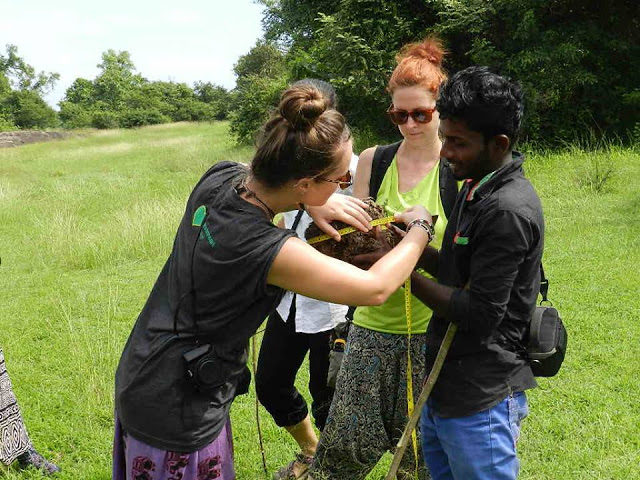Every morning we drive out to a specific area to do a transect, which involves walking along a planned route in search of signs of elephant activity. When we find elephant dung we note the GPS coordinates, measure the circumference of the dung, estimate how old the sample is, and examine the contents. By examining the contents we can see what the elephants have been eating – we are especially interested in finding if the elephants have been raiding farmer’s crops or raiding the local dump site. We have found plastic pieces in various dung samples, including in calf dung.
During the middle, hottest part of the day we have a break back at the field house to chill out and spend our time how we like. After lunch we head out again to the dump, treehouse or tank to sit quietly and wait for elephants. If elephants are present we observe and take data on the number of individual elephants, as well as their sex, age and behaviour. We also take data on the number of humans who go past, their transport mode, how noisy they are, whether there are any attempts to move the elephants on and how the elephants respond to this. It is not uncommon for locals to yell at elephants to try and move them along – it is an extremely negative relationship. The elephants here can be quite aggressive due to this, and the farmers do shoot the elephants, yet they do not admit to this.

The rubbish dump – a scary contrast between the dump and the beautiful nature.

Observing this sneaky guy from the treehouse.
Sometimes instead of going with the other volunteers, we can go with Kylie to visit her village which has the beehive fences. I don’t know how much you readers know about elephant research at the moment, but in Africa it was discovered that elephants do not like bees. This means that beehive fences are a great biological deterrent for elephants, to try and keep them out of human habituated areas. Kylie has been carrying out this work here in Sri Lanka, and she is hoping to get some great results. It is really exciting the work that is being done here!
It was awesome, when I went to visit the fences, one of the farmers climbed up his coconut tree and cut down some coconuts for us. He then chopped off the tops and we guzzled the coconut water down, spilling it all over ourselves. He then cut them in half and we scraped out the flesh. Now that is how you enjoy a coconut!

Don’t beehive fences look fun?!

The farmer with his lovely bunch of coconuts, and his beautiful daughter.
On Friday afternoons Kylie and Bri go to Wasgamuwa National Park, and two lucky volunteers get to go along with them. The national park is really beautiful with lots of spotted deer, peacocks, tonnes of birds, leopard (good luck finding one), jackals and of course, elephants. Lots and lots of elephants. Although the elephants like to be illusive and come out right before the sun sets, which makes it super difficult to count them and to video them.

Indian Roller – was so psyched to get such a great photo

Just a few favourite photos from Wasgamuwa National Park
In the evenings we go back to the field house and have dinner, which usually consists of curry, daal, rotty and whatever other delicious dishes Leela and Sawana come up with! After dinner we splurge out on curd with coconut treacle, which is delicious – it tastes like natural yoghurt without as strong a flavour. We are usually in bed pretty early as the heat really takes the energy out of you, and we wake up so early too.
So that’s it…that is an average day at the field house. I bet you all want to come along and volunteer now too, right?!
